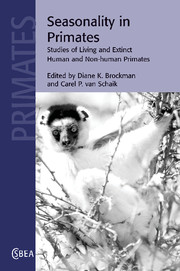Book contents
- Frontmatter
- Contents
- List of contributors
- Preface
- Part I Introduction
- Part II Seasonal habitats
- Part III Seasonality and behavioral ecology
- 3 The influence of seasonality on primate diet and ranging
- 4 Seasonality in predation risk: varying activity periods in lemurs and other primates
- 5 Physiological adaptations to seasonality in nocturnal primates
- 6 Seasonality and long-term change in a savanna environment
- 7 Day length seasonality and the thermal environment
- 8 Seasonality in hunting by non-human primates
- 9 Human hunting seasonality
- Part IV Seasonality, reproduction, and social organization
- Part V Seasonality and community ecology
- Part VI Seasonality and human evolution
- Index
- References
8 - Seasonality in hunting by non-human primates
Published online by Cambridge University Press: 10 August 2009
- Frontmatter
- Contents
- List of contributors
- Preface
- Part I Introduction
- Part II Seasonal habitats
- Part III Seasonality and behavioral ecology
- 3 The influence of seasonality on primate diet and ranging
- 4 Seasonality in predation risk: varying activity periods in lemurs and other primates
- 5 Physiological adaptations to seasonality in nocturnal primates
- 6 Seasonality and long-term change in a savanna environment
- 7 Day length seasonality and the thermal environment
- 8 Seasonality in hunting by non-human primates
- 9 Human hunting seasonality
- Part IV Seasonality, reproduction, and social organization
- Part V Seasonality and community ecology
- Part VI Seasonality and human evolution
- Index
- References
Summary
Introduction
Primates obtain most of their food from plants (Oates 1987), but some species are well known for their predatory behavior. Chimpanzees (Pan troglodytes) were the first non-human primates observed to hunt and eat meat in the wild (Goodall 1963). Subsequent field observations of baboons (Papio spp.) and capuchin monkeys (Cebus capucinus) have shown them to be proficient hunters (Harding 1973, 1975; Strum 1975, 1981; Hausfater 1976; Fedigan 1990; Perry & Rose 1994; Rose 1997, 2001). Given seasonal variations in primate feeding patterns (see Chapter 3), it is not surprising that primate predators display temporal variation in their tendencies to hunt. Studies of primate hunting seasonality generate considerable ecological and ethological interest and take on additional significance because of their potential to shed light on the evolution of meat-eating by early hominids (see Chapters 17 and 19). Systematic attempts to describe seasonal variation in hunting activity by non-human primates and efforts to identify its causal factors, however, have not been made.
In this chapter, we provide an overview of seasonal variation in primate predatory behavior. We focus on chimpanzees, baboons, and capuchin monkeys, three species for which sufficient observations exist to make comparisons. We begin by reviewing data on temporal variation in hunting frequency and success by each species. We proceed to discuss the factors that appear to affect this variation. Here, we consider several ecological factors that have been hypothesized to affect temporal variation in hunting (Table 8.1).
- Type
- Chapter
- Information
- Seasonality in PrimatesStudies of Living and Extinct Human and Non-Human Primates, pp. 215 - 242Publisher: Cambridge University PressPrint publication year: 2005
References
- 14
- Cited by



